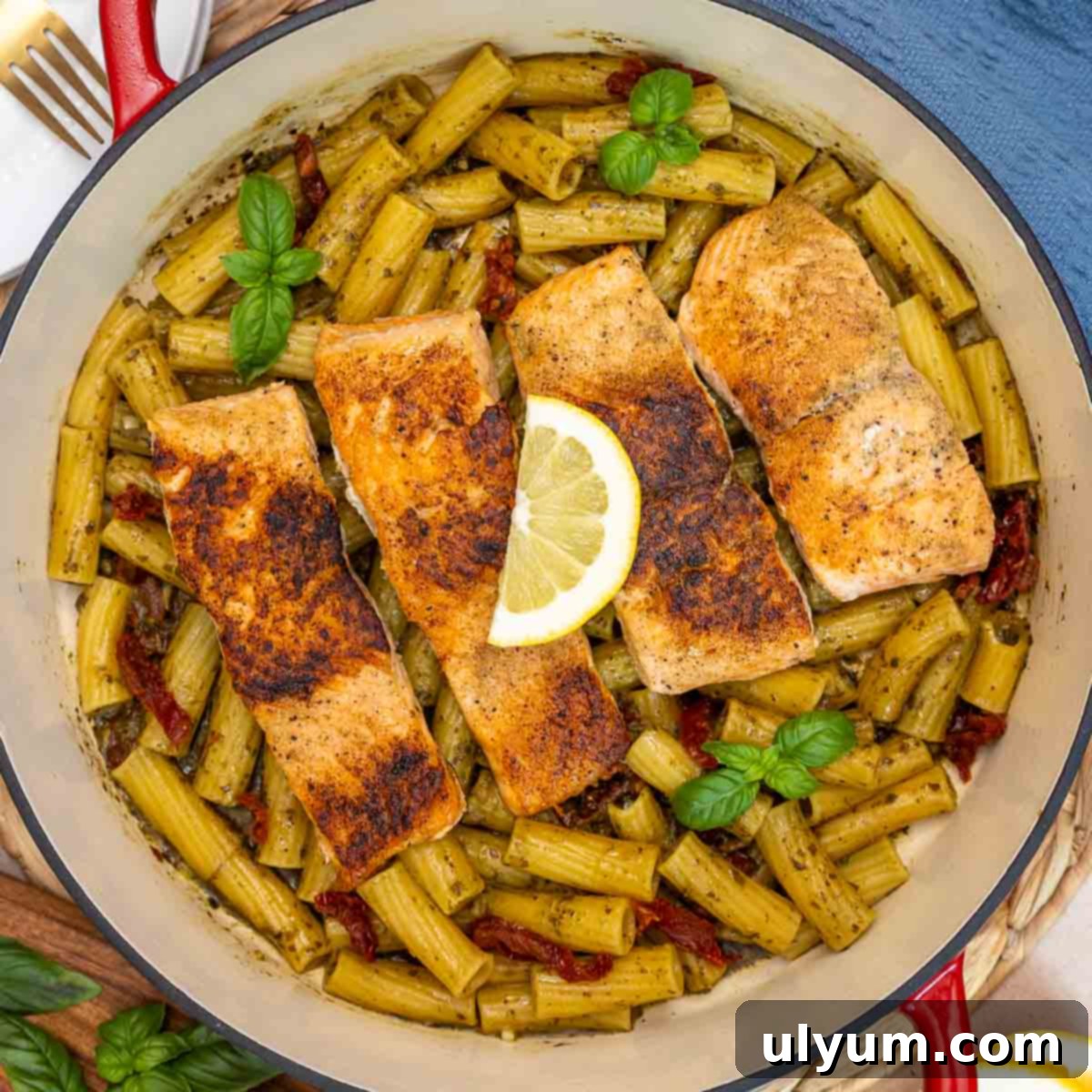Delicious One-Pan Salmon Pesto Pasta: Your Quick & Easy 30-Minute Weeknight Meal
This one-pan salmon pesto pasta is truly a dinner recipe that checks every box on your list. It’s incredibly quick to prepare, bursting with vibrant flavors, and surprisingly simple to master. Salmon, with its rich texture and beautiful color, often feels like a gourmet choice, yet it’s one of the easiest proteins to cook perfectly right at home.
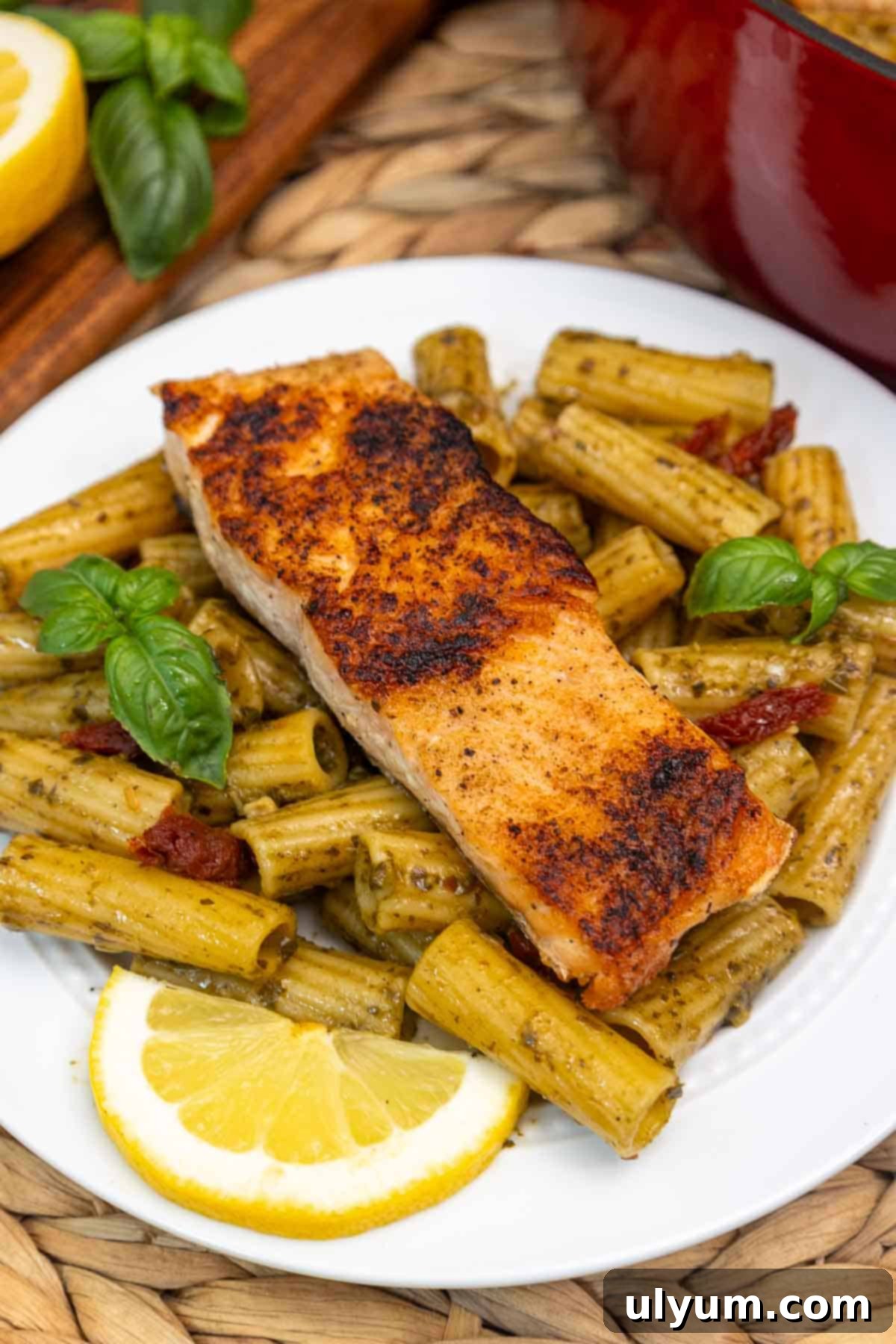
Imagine tender, flaky salmon fillets paired with perfectly al dente pasta, all coated in a rich, creamy basil pesto sauce. The best part? This entire culinary experience comes together in just a single pan, significantly cutting down on your cleanup time. By cooking everything together, the pasta absorbs all the delicious browned bits (fond) from the bottom of the pan, infusing every bite with maximum flavor and creating an irresistible depth that multi-pot recipes often miss.
If you’re seeking an elevated pasta dish that can be on your table in under 30 minutes, look no further. Using quality jarred pesto is your secret weapon, delivering robust basil flavor with minimal effort. A final squeeze of fresh lemon juice acts as a bright counterpoint, lifting all the flavors and bringing the dish to life. This easy pesto salmon pasta recipe is wonderfully versatile, equally perfect for a busy weeknight dinner or a special date night at home.
For more quick and flavorful seafood ideas, make sure to try my pesto crusted salmon or my one pot lemon garlic shrimp pasta.
Why You’ll Love This One-Pan Salmon Pesto Pasta
This recipe isn’t just another meal; it’s a culinary revelation for busy home cooks who crave deliciousness without the fuss. Here’s why this one-pan salmon pesto pasta will quickly become a favorite in your kitchen:
- Effortless One-Pan Cooking: Say goodbye to piles of dishes! The entire meal – from searing the salmon to cooking the pasta and creating the creamy pesto sauce – is prepared in a single skillet. This method not only simplifies cleanup but also concentrates flavors, as the pasta cooks directly in the seasoned broth.
- Lightning-Fast 30-Minute Dinner: Time is precious, and this recipe respects that. Designed to be on your table in under half an hour, it’s the perfect solution for busy weeknights when you need a flavorful, satisfying, and quick meal without resorting to takeout.
- Flavorful Shortcut with Jarred Pesto: We embrace smart shortcuts! By utilizing quality store-bought basil pesto, you get a huge flavor boost without the time-consuming process of making pesto from scratch. Paired with jarred sun-dried tomatoes, it adds depth and Mediterranean flair with minimal prep.
- Elegant Yet Simple: Salmon inherently feels a bit luxurious, making this dish feel special enough for guests or a romantic evening, yet it’s incredibly straightforward to prepare.
Essential Ingredients for Salmon Pesto Pasta
Creating this incredible one-pan salmon pesto pasta requires just a handful of fresh and flavorful ingredients. Each component plays a crucial role in building the dish’s rich taste and satisfying texture. Here’s what you’ll need:
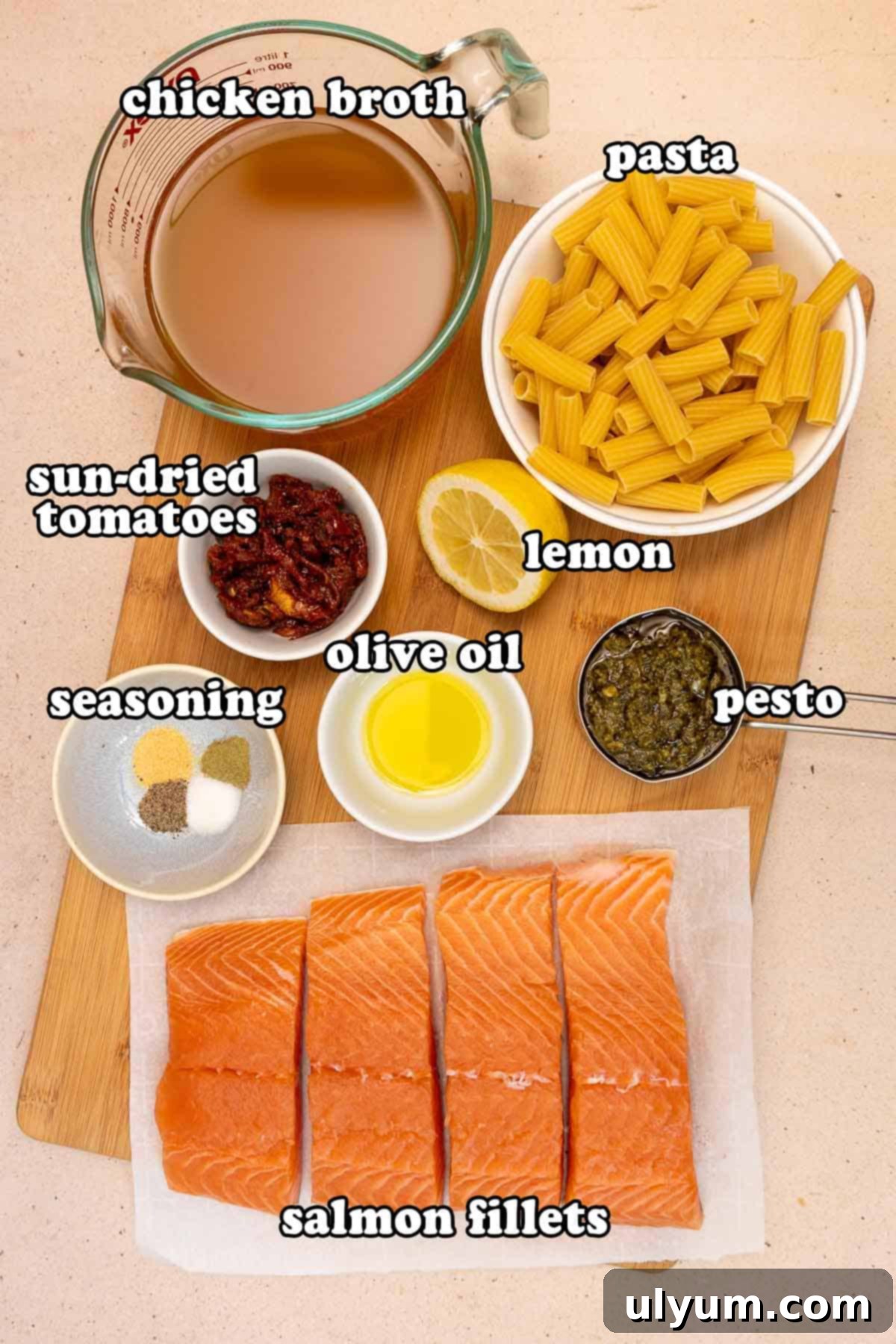
- Salmon Fillets: Opt for fresh, skin-on Atlantic salmon fillets. The skin helps protect the fish and adds flavor. Aim for pieces about 1 to 1¼ inches thick for optimal cooking time and moisture retention.
- Seasoning: A simple blend of garlic powder, dried thyme, salt, and black pepper enhances the salmon’s natural flavors without overpowering them.
- Olive Oil: Essential for searing the salmon to a beautiful golden crisp and for building a flavorful base in the pan for the sauce.
- Chicken Broth: This is key for cooking the pasta directly in the pan and infusing it with savory notes, contributing significantly to the overall sauce.
- Short Pasta: Varieties like penne, rigatoni (as pictured), fusilli, or rotini are ideal. Their shapes are excellent for catching and holding the creamy pesto sauce, ensuring every bite is flavorful.
- Basil Pesto: Your favorite jarred pesto is perfect here! It’s a fantastic shortcut that delivers rich, aromatic basil flavor without any extra effort.
- Lemon Juice: A splash of fresh lemon juice is crucial for brightening the pesto sauce and cutting through the richness, balancing the flavors beautifully.
- Sun-Dried Tomatoes: Drained and chopped, these provide a concentrated burst of sweet and tangy flavor, adding a delightful depth to the pasta.
Find exact quantities and more detailed notes in the complete recipe card below.
How to Make One-Pan Salmon Pesto Pasta: Step-by-Step Guide
Follow these easy steps to create a delicious and satisfying one-pan salmon pesto pasta that’s perfect for any occasion. This method ensures maximum flavor and minimal cleanup!
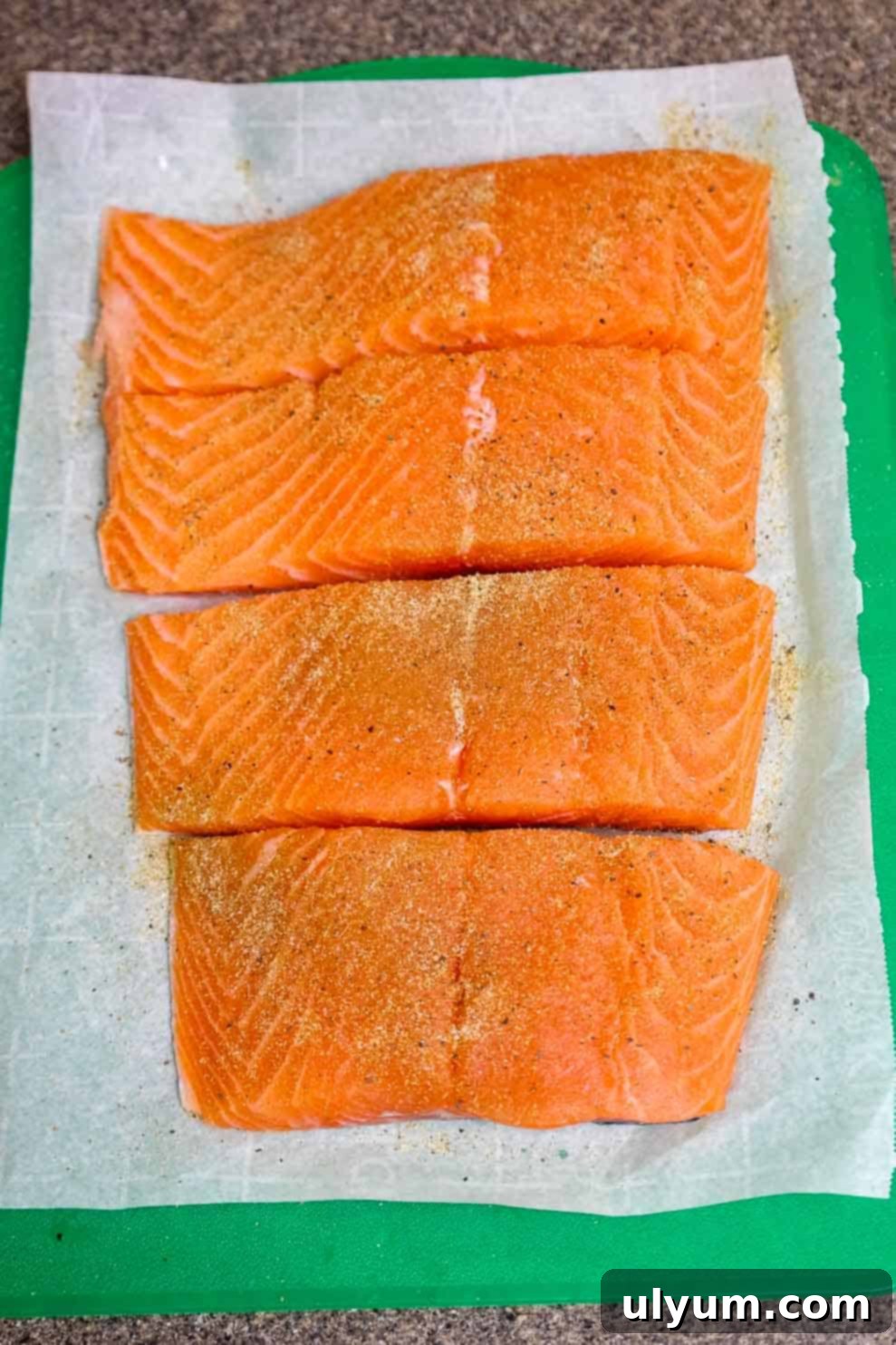
1. Prepare the Salmon: Begin by thoroughly patting your salmon fillets dry with paper towels. This crucial step helps achieve a perfectly crispy skin. Season the flesh sides generously with garlic powder, dried thyme, salt, and black pepper. Don’t season the skin side, as it tends to burn and doesn’t absorb the flavors as well.
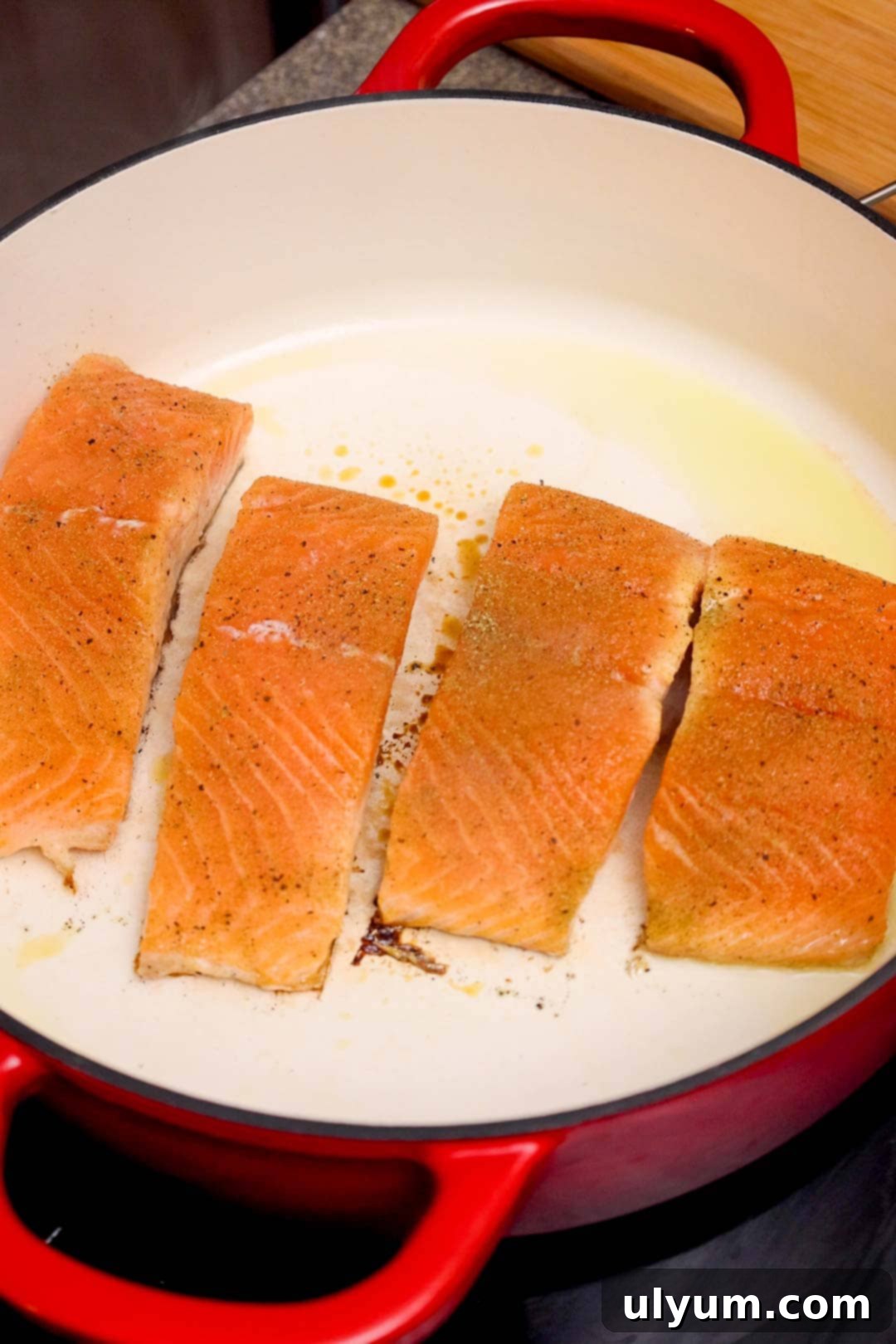
2. Sear the Salmon: Heat the olive oil in a large, deep skillet (a Dutch oven or braiser works perfectly) over medium heat. Once shimmering, carefully place the seasoned salmon fillets skin-side down in the pan. Cook for approximately 5–6 minutes. You’ll know it’s time to flip when the opaque, cooked portion of the fish reaches about halfway up the sides of the fillet, indicating a beautiful, crispy skin has formed.

3. Finish Cooking Salmon: Gently flip the salmon fillets and cook for another 4–5 minutes, or until the fish is entirely opaque throughout and flakes effortlessly with a fork. While the USDA recommends an internal temperature of 145°F (63°C), many chefs prefer a slightly lower temperature of 130–135°F (54–57°C) for a moister result. Remember, the temperature will continue to rise slightly as the fish rests. Remove the cooked salmon from the skillet and set it aside. Once it’s slightly cooled, you can easily peel off the skin if preferred, though many enjoy its crispy texture.

4. Deglaze the Pan: Carefully wipe out most of the excess oil from the skillet, but be sure to leave all the flavorful browned bits (known as “fond”) at the bottom of the pan. This is where a lot of the magic happens! Add the chicken broth and increase the heat to medium-high. As the liquid warms up, use a sturdy wooden spoon to scrape up all those flavorful bits from the bottom. This process, called deglazing, adds incredible depth and complexity to your sauce.
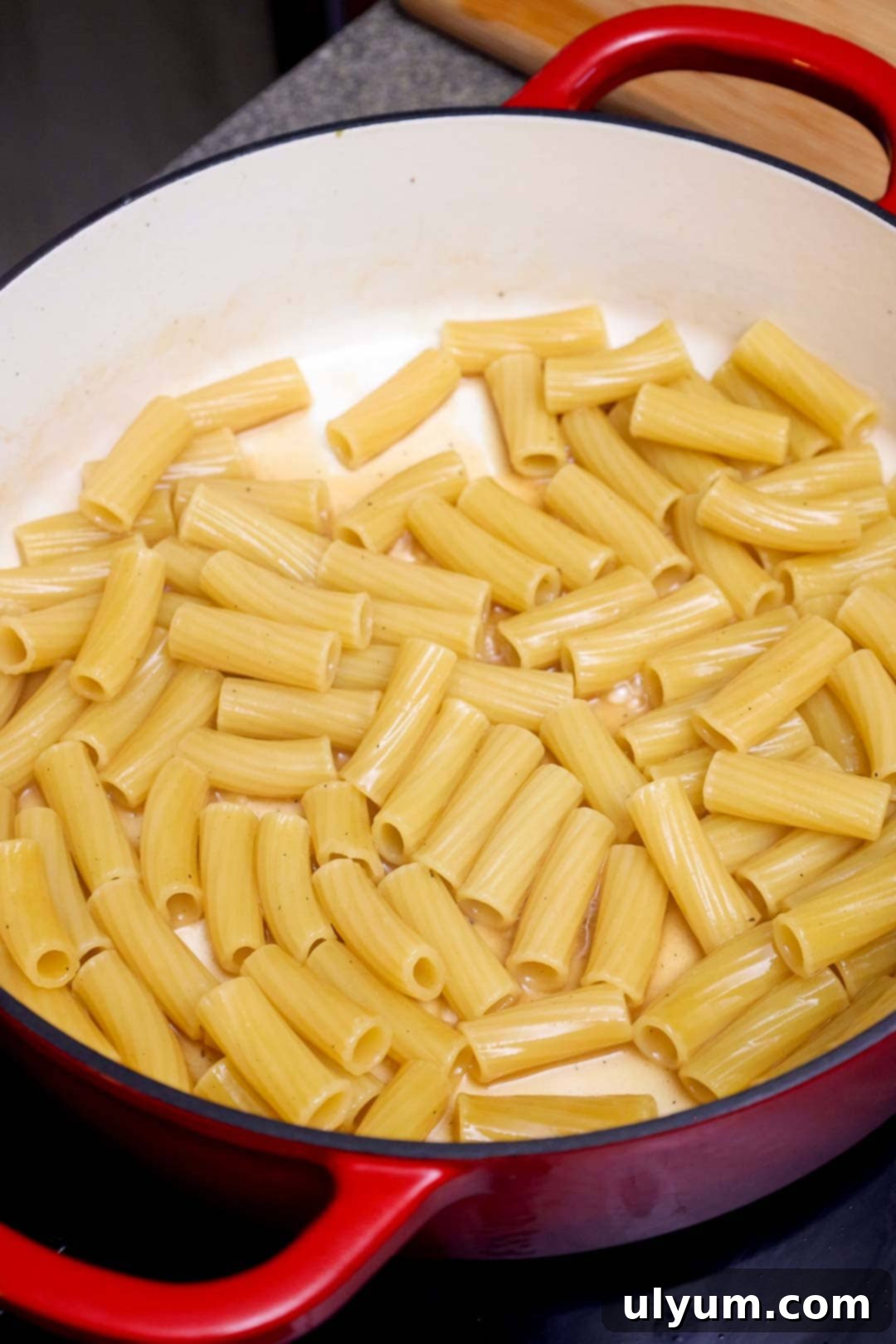
5. Cook the Pasta: Stir in your chosen short pasta and bring the liquid to a rolling boil. Once boiling, reduce the heat to a gentle simmer, cover the skillet, and let it cook for approximately 10–12 minutes. Stir occasionally to prevent the pasta from sticking and to ensure even cooking. The pasta should become tender, and most of the liquid should be absorbed, creating a rich starchy base for your sauce. If the pasta starts to stick or the liquid evaporates too quickly before the pasta is fully cooked, don’t hesitate to add an extra splash of broth or water.
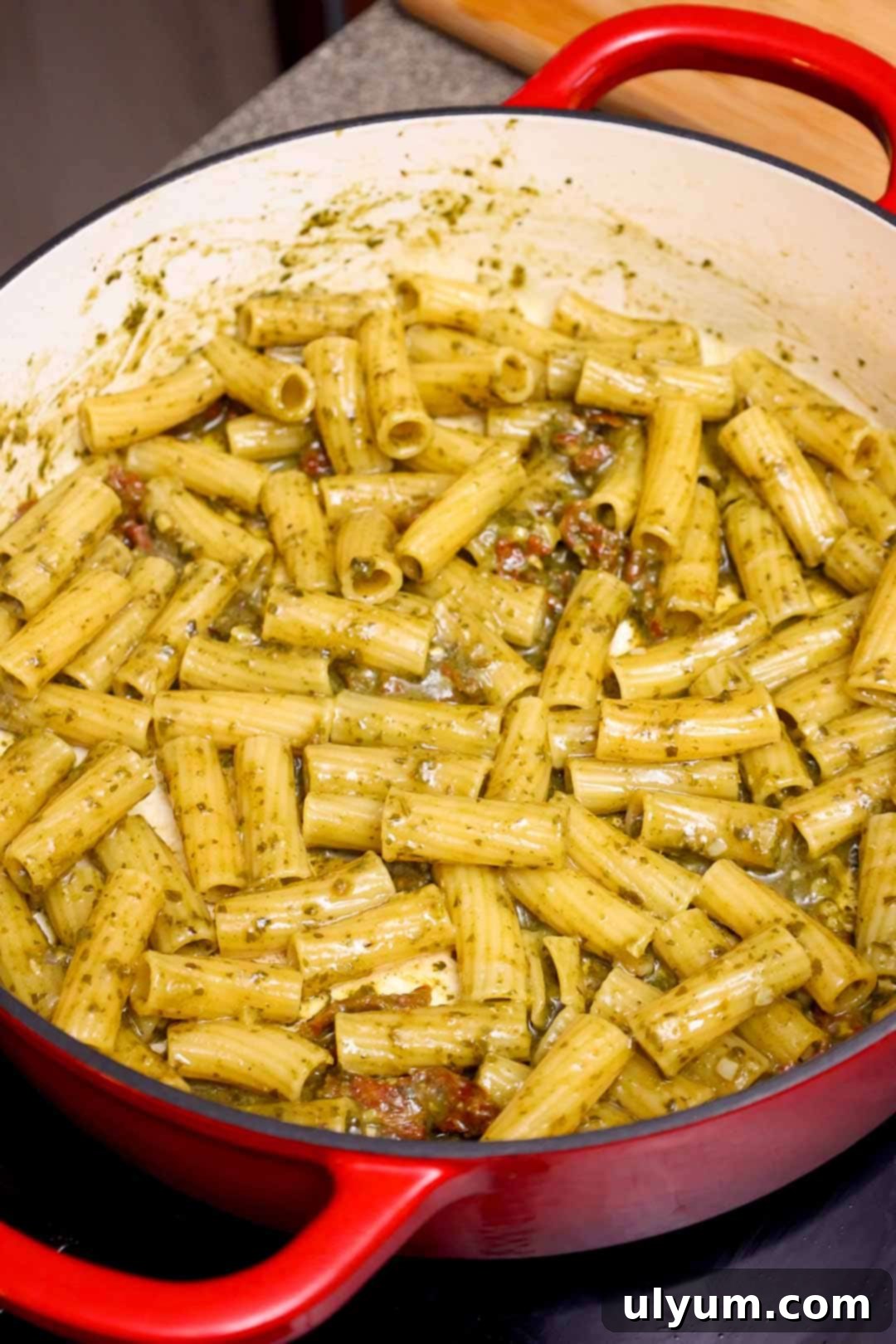
6. Finish the Sauce: Once the pasta is tender, remove the skillet from the heat. Stir in the jarred basil pesto, the freshly squeezed lemon juice (adjust to your taste – a little extra can be wonderful!), and the chopped sun-dried tomatoes. Stir everything together until the sauce is thoroughly heated through and coats the pasta beautifully. The residual heat from the pasta and pan will be enough to warm the pesto without overcooking it, preserving its fresh flavor.
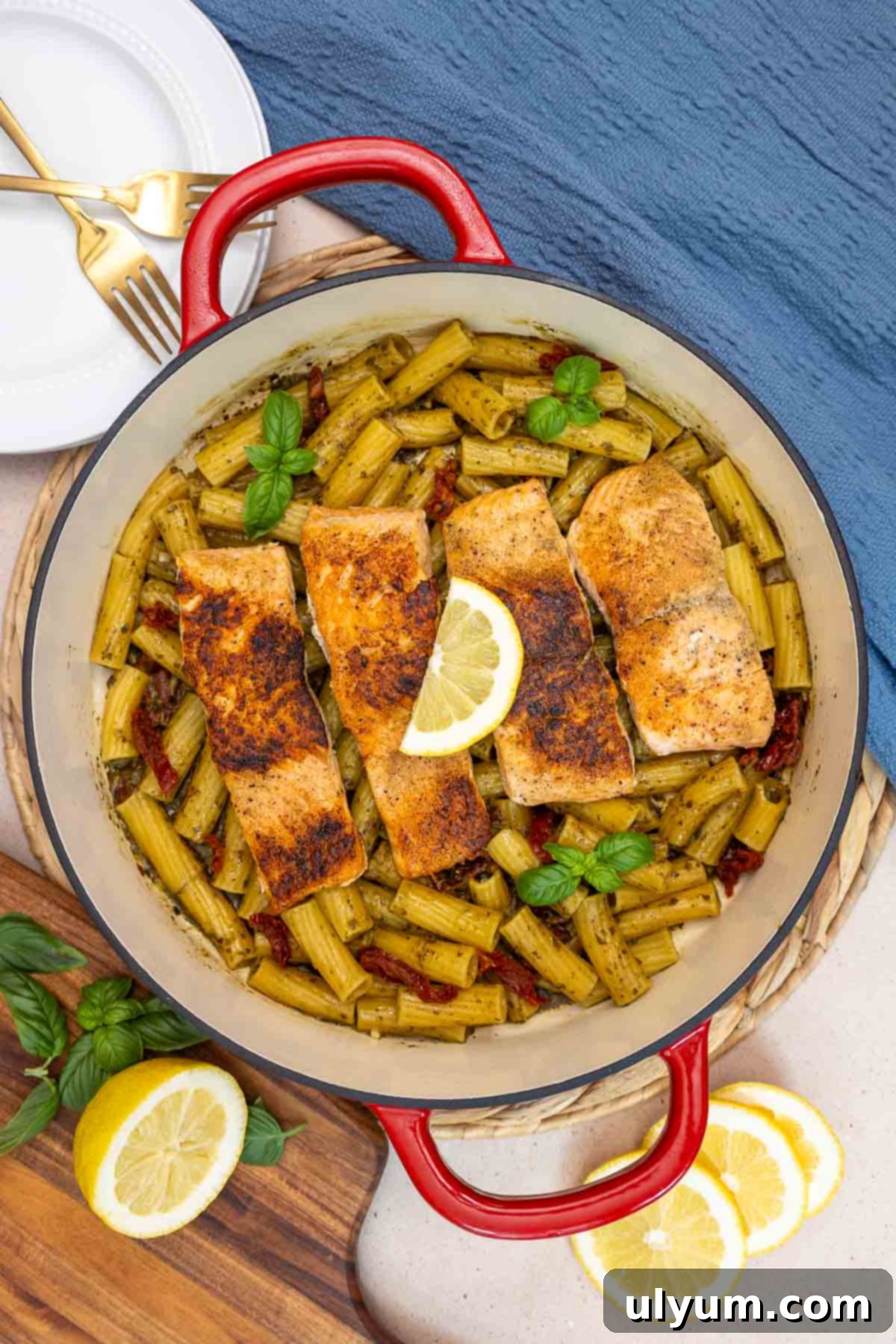
7. Serve and Enjoy: Arrange the seared salmon fillets whole over the pasta, or gently flake the salmon into the pasta for a more integrated dish. Taste the pasta and adjust the seasoning (salt, pepper, or a touch more lemon) if needed. Serve your beautiful one-pan salmon pesto pasta warm, garnished with fresh basil or a sprinkle of Parmesan cheese for an extra flourish. Enjoy this quick, flavorful, and incredibly satisfying meal!
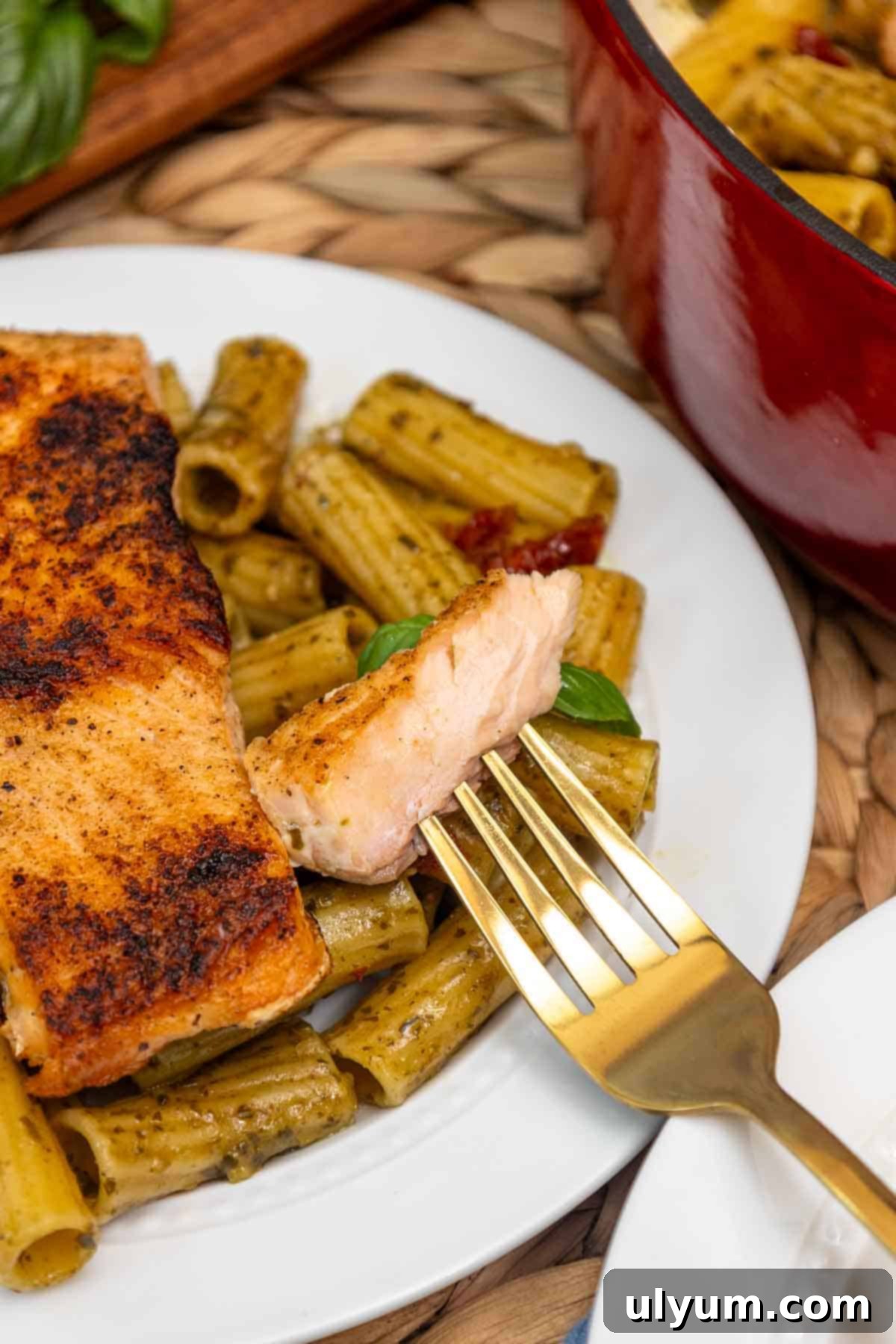
Flavorful Variations & Substitutions for Your Pesto Salmon Pasta
One of the beauties of this one-pan salmon pesto pasta recipe is its flexibility. Feel free to customize it based on what you have on hand or your dietary preferences. Here are some fantastic substitutions and additions:
- Salmon Fillets: While Atlantic salmon is recommended for its richness, you can absolutely use other types like Sockeye or Coho salmon. If buying a large piece, cut it into individual fillets of similar thickness for even cooking. Frozen salmon works perfectly, just ensure it’s fully thawed and patted dry before seasoning and searing. If you prefer skinless fillets, they will cook slightly faster and be more delicate when flipping. For a non-fish option, cooked chicken breast or shrimp would be delicious, as would firm tofu for a vegetarian twist. Adjust cooking times accordingly.
- Chicken Broth: Chicken broth adds savory depth, but you can easily substitute it with vegetable broth for a vegetarian version. If you only have water, use it, but be sure to add an extra pinch of salt to compensate for the missing flavor. A bouillon cube dissolved in water is also a great alternative.
- Jarred Pesto: Store-bought pesto is a fantastic time-saver, but if you have a favorite homemade basil pesto recipe, it will elevate this dish even further. Don’t be afraid to experiment with other pesto varieties too, such as sun-dried tomato pesto or even a roasted red pepper pesto for a different flavor profile.
- Pasta Options: Any short pasta that can hold sauce well will work. Besides rigatoni, penne, fusilli, or rotini, consider farfalle (bow-tie pasta) or orecchiette. Gluten-free pasta can also be used; just follow package directions as cooking times may vary.
- Add More Vegetables: Boost the nutritional value and texture by incorporating more vegetables. Stir in a few handfuls of fresh spinach or chopped kale with the pesto, or add halved cherry tomatoes, asparagus tips, or broccoli florets during the last few minutes of the pasta’s simmering time.
- Cheese: While the recipe doesn’t explicitly call for it, a generous sprinkle of grated Parmesan cheese or crumbled feta cheese when serving will add a wonderful salty, tangy finish.
Essential Kitchen Tools for Your One-Pan Pasta
The beauty of this recipe lies in its simplicity and minimal equipment needs. As a true one-pan dinner, you won’t need much, but having the right tools makes the process even smoother and more enjoyable. Here’s what you’ll want:
- Large Skillet or Dutch Oven: This is your star player! A large, deep skillet, preferably one with high sides, is essential. I personally love using my 5-quart cast-iron braiser because its wide base provides ample surface area for searing the salmon perfectly and then accommodates all the pasta comfortably, ensuring even cooking and sauce distribution. A good quality non-stick pan can also work wonders.
- Chef’s Knife: A sharp chef’s knife is indispensable for precisely chopping the sun-dried tomatoes and, if you’re starting with a larger fillet, for slicing the salmon into individual portions.
- Cutting Board: A sturdy cutting board provides a safe and stable surface for all your chopping and prep work.
- Tongs or Spatula: For easily flipping the salmon and stirring the pasta without scratching your pan.
- Measuring Cups & Spoons: For accurate ingredient quantities, though this recipe is quite forgiving.
Mastering Your One-Pan Salmon Pesto Pasta: Tips from the Kitchen
Developing this one-pan salmon pesto pasta recipe involved quite a bit of testing to ensure perfect results every time. Here are some key insights and tips I learned along the way that will help you achieve a truly restaurant-quality dish:
- Salmon Thickness Matters Immensely. This is perhaps the most critical factor for success. If your salmon fillets are too thick (e.g., over 1.5 inches), they simply won’t cook through quickly enough to match the pasta’s cooking time, or they might overcook on the outside before the inside is done. Aim for fillets that are consistently 1 to 1¼ inches thick. This ensures even cooking and juicy, flaky results.
- Always Start with Salmon Skin-Side Down. This isn’t just a suggestion; it’s a golden rule for cooking salmon. Starting with the skin-side down accomplishes several things: it protects the delicate flesh from direct, intense heat, helping it stay incredibly moist; it allows the skin to render its fat, creating an irresistibly crispy layer; and it ensures the skin is fully cooked and easy to remove if you prefer not to eat it. Even if you’re not a fan of salmon skin, I highly recommend cooking with it on. It acts as a protective barrier, and once the salmon is cooked and slightly cooled, the crispy skin will easily peel away from the flesh.
- Don’t Overcrowd the Pan. If you have too many salmon fillets for your skillet, cook them in batches. Overcrowding lowers the pan’s temperature and steams the fish instead of searing it, preventing that beautiful golden crust.
- The Power of Deglazing. Those browned bits (fond) left in the pan after searing the salmon are pure flavor. Don’t discard them! Deglazing with chicken broth is a simple technique that captures all that savory goodness and incorporates it into your pasta sauce, adding an incredible depth that truly makes this a one-of-a-kind dish.
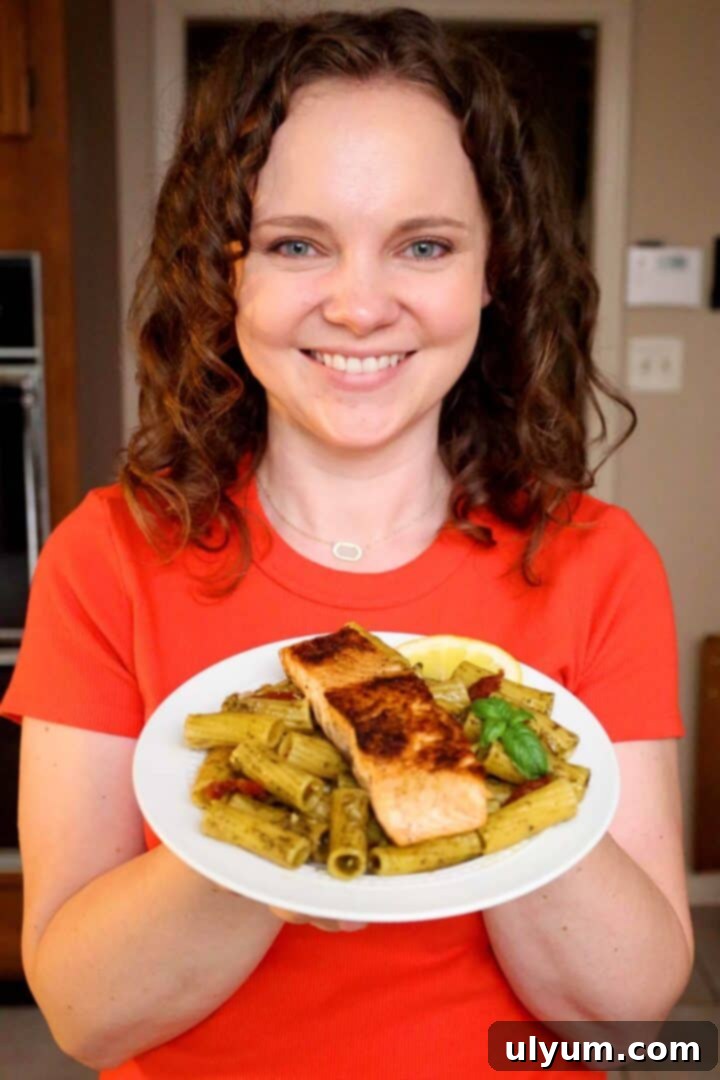
Did you make this recipe? I’d love to hear what you think! Please take a moment to leave a rating and review—it helps me create high-quality recipes and lets others know what to expect. Your feedback is truly appreciated!
Frequently Asked Questions About One-Pan Salmon Pesto Pasta
The best way to tell if salmon is cooked is by checking its internal temperature with a meat thermometer. The USDA recommends 145°F (63°C), but for a flakier, juicier texture, many chefs prefer to remove it from heat between 130–135°F (54–57°C), as it will continue to cook slightly while resting. Visually, the salmon should appear opaque throughout and flake easily with a fork.
Yes, you absolutely can use skinless salmon fillets. However, be aware that skinless salmon tends to cook slightly faster and is more delicate, making it a bit trickier to flip in the pan without breaking. Cook it carefully and watch for visual cues of doneness.
No, that’s the beauty of this one-pan recipe! The pasta cooks directly in the chicken broth, and as it simmers, the liquid reduces and combines with the pasta’s starches to create a rich, flavorful sauce. You do not need to drain it. Just stir occasionally to prevent sticking and add a splash more broth or water if the pan seems too dry before the pasta is fully cooked.
Yes, you can. Ensure your basil pesto is dairy-free (many jarred varieties are, but check the label as some contain Parmesan). Avoid adding any optional cheese garnishes. The rest of the ingredients in this recipe are naturally dairy-free.
Store any leftover salmon pesto pasta in an airtight container in the refrigerator for up to 3-4 days. When reheating, gently warm on the stovetop over low heat with a splash of broth or water to loosen the sauce, or microwave in short bursts. The texture of the salmon will be best if reheated carefully to avoid drying it out.
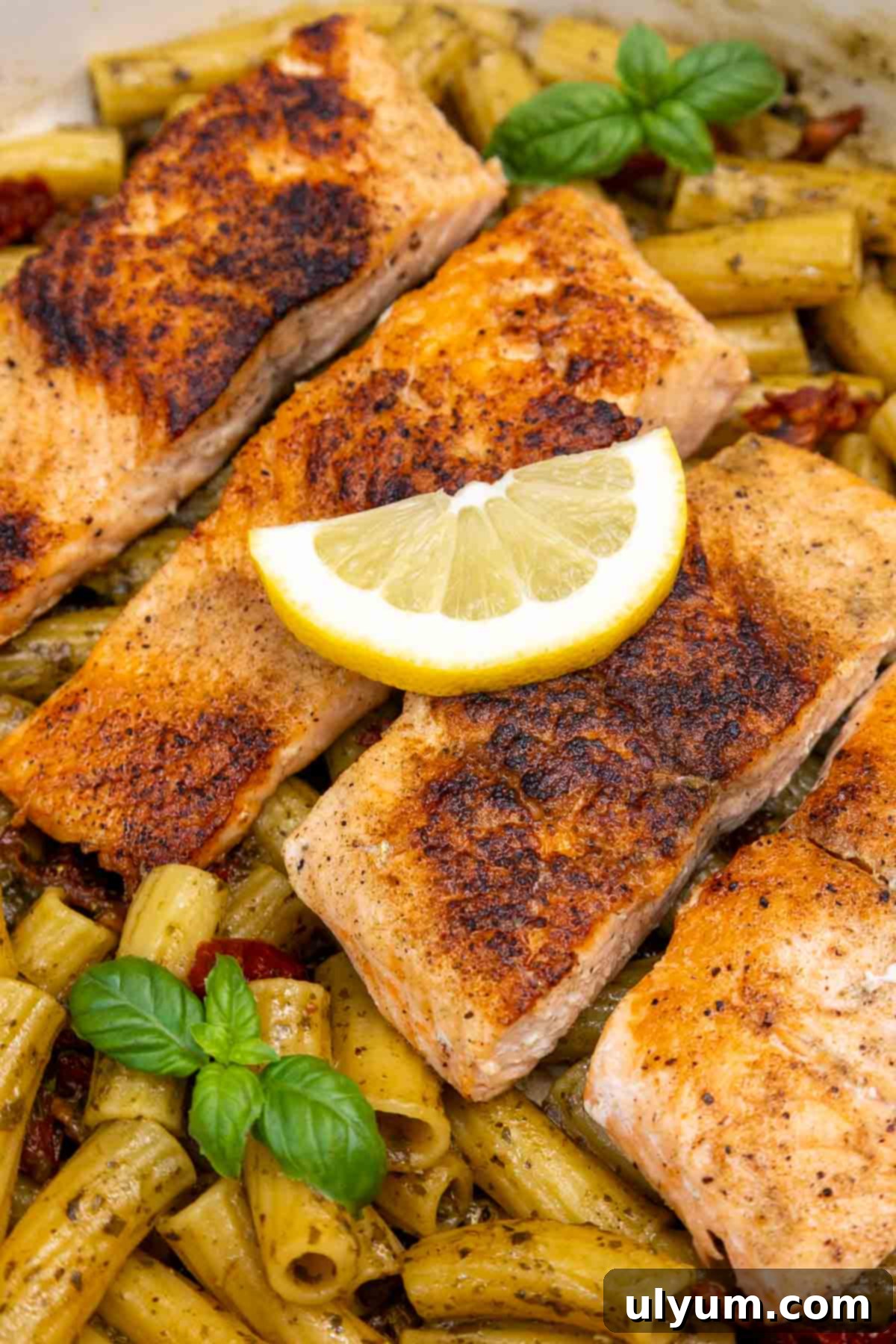
📖 Recipe Card: One-Pan Salmon Pesto Pasta

Pin Recipe
Save RecipeSaved!
Email
Print
One Pan Salmon Pesto Pasta
Equipment
-
Large skillet
-
Chef’s knife
-
Cutting board
Ingredients
- 4 skin-on Atlantic salmon fillets 4 to 6 oz each, about 1 to 1¼ inches thick
- ¼ teaspoon garlic powder
- ¼ teaspoon dried thyme
- ¼ teaspoon salt
- ⅛ teaspoon black pepper
- 1 tablespoon olive oil
- 2 ¼ cups chicken broth or water
- 8 oz short pasta like rigatoni, fusilli, penne, or rotini
- ½ cup jarred basil pesto
- ½ lemon juiced
- ⅓ cup oil-packed sun-dried tomatoes drained and chopped
Instructions
-
Pat the salmon dry with paper towels. Season the flesh sides with garlic powder, dried thyme, salt, and pepper.
-
Heat olive oil in a large deep skillet over medium heat. Place the salmon fillets skin-side down in the pan. Cook for about 5–6 minutes or until the cooked (opaque) part reaches about halfway up the sides.
-
Flip and cook for an additional 4–5 minutes, or until the fish is opaque and flakes easily with a fork (see notes below for internal temp tips). Remove the salmon from the skillet and set aside. Once slightly cooled, peel off the skin if desired.
-
Carefully wipe out most of the excess oil from the skillet, leaving the browned bits (fond) in the pan. Add the broth and increase heat to medium-high. As the liquid heats, use a wooden spoon to scrape up the fond and deglaze the pan, this adds great flavor to the sauce.
-
Stir in the pasta and bring to a boil. Reduce the heat, cover, and simmer for about 10–12 minutes, stirring occasionally, until the pasta is tender and most of the liquid is absorbed. If the pasta is uncooked and begins to stick to the pan, add an extra splash of broth or water until it is done cooking.
-
Stir in the jarred pesto, lemon juice (adjust to taste), and chopped sun-dried tomatoes. Stir until the sauce is heated through then remove from the heat.
-
Serve the salmon whole or flaked over the pasta. Taste and adjust seasoning if needed. Serve warm.
Video
Notes
Storage: Store leftover salmon pesto pasta in an airtight container in the refrigerator for 3 to 4 days. Reheat gently on the stovetop or microwave. This pasta dish can be frozen, but the oils from the sauce may separate upon thawing. If freezing, simply give it a good stir when reheating to re-emulsify the sauce.
Nutrition
Important Food Safety Guidelines
Ensuring food safety is paramount when cooking any meal, especially with seafood. Please follow these guidelines to keep your kitchen and your plate safe and healthy:
- The USDA recommends cooking salmon to an internal temperature of 145°F (63°C) to ensure it’s safe to eat. Use a reliable meat thermometer for accuracy.
- Always wash your hands thoroughly with soap and water before and after handling raw fish.
- Use separate cutting boards and utensils for raw fish and other ingredients to prevent cross-contamination. Clean all surfaces that have come into contact with raw fish immediately.
- Store any cooked salmon and pasta leftovers in an airtight container in the refrigerator within two hours of cooking. Do not leave perishable food at room temperature for extended periods.
- Keep opened jars of pesto refrigerated and consume them within the timeframe recommended on the packaging.
For more comprehensive food safety information and guidelines, please refer to USDA.gov.
Discover More Easy One-Pot and One-Pan Meals
Loved the convenience and flavor of this one-pan salmon pesto pasta? If you’re looking to simplify your cooking and reduce cleanup without sacrificing taste, you’re in luck! Here are some other fantastic one-pot and one-pan recipes that are perfect for busy weeknights or when you just want a delicious meal with minimal effort:
- One Pan Lemon Chicken Orzo
- One Pan Salmon Pesto Pasta
- One Pan Coconut Lime Chicken
- One Pan Creamy Garlic Pork Chops
